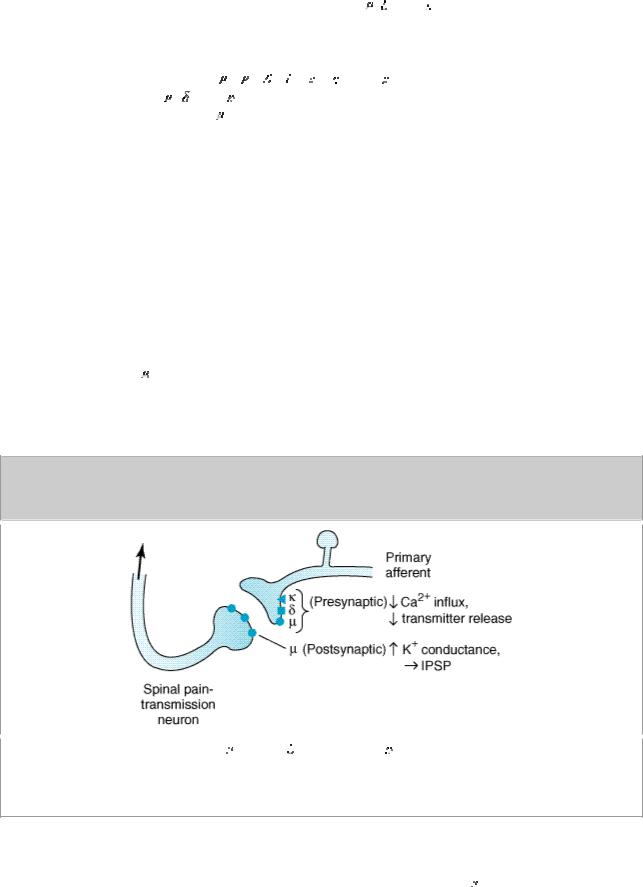
Книги фарма 2 / Bertram G. Katzung-Basic & Clinical Pharmacology(9th Edition)
.pdf
Chapter 31. Opioid Analgesics & Antagonists
Katzung PHARMACOLOGY, 9e > Section V. Drugs That Act in the Central Nervous System > Chapter 31. Opioid Analgesics & Antagonists >
Opioid Analgesics & Antagonists: Introduction
Morphine, the prototypical opioid agonist, has long been known to relieve severe pain with remarkable efficacy. The opium poppy is the source of crude opium from which Serturner in 1803 isolated the pure alkaloid morphine—named after Morpheus, the Greek god of dreams. It remains the standard against which all drugs that have strong analgesic action are compared. These drugs are collectively known as "opioid analgesics" and include not only the natural and semisynthetic alkaloid derivatives from opium but also include synthetic surrogates, other opioid-like drugs whose actions are blocked by the nonselective antagonist naloxone, plus several endogenous peptides that interact with the several subtypes of opioid receptors.
Katzung PHARMACOLOGY, 9e > Section V. Drugs That Act in the Central Nervous System > Chapter 31. Opioid Analgesics & Antagonists >
Basic Pharmacology of the Opioid Analgesics
Source
Incision of the poppy seed pod reveals a white substance that turns into a brown gum that is crude opium. Opium contains many alkaloids, the principle one being morphine which is present in a concentration of about 10%. Codeine is synthesized commercially from morphine.
Classification & Chemistry
Opioid drugs include full agonists, partial agonists, and antagonists (see Chapter 2: Drug Receptors & Pharmacodynamics for definitions). Figure 31–1 shows the chemical structures of morphine, a natural opioid; codeine, a semisynthetic opioid; fentanyl, a pharmacologically similar synthetic; and naloxone, a nonselective opioid antagonist. Morphine is a full agonist at the (mu) opioid receptor, whereas codeine functions as a partial (or "weak")  receptor agonist. As shown in Figure 31–1, simple substitution of an allyl group on the nitrogen of the full agonist morphine plus addition of a single hydroxyl group results in naloxone, a strong
receptor agonist. As shown in Figure 31–1, simple substitution of an allyl group on the nitrogen of the full agonist morphine plus addition of a single hydroxyl group results in naloxone, a strong  receptor antagonist. Some opioids, eg, nalbuphine, are capable of producing an agonist (or partial agonist) effect at one opioid receptor subtype and an antagonist effect at another. Not only can the activating properties of opioid analgesics be manipulated by pharmaceutical chemistry, certain opioid analgesics are modified in the liver resulting in compounds with greater analgesic action (see below, Pharmacokinetics, Metabolism).
receptor antagonist. Some opioids, eg, nalbuphine, are capable of producing an agonist (or partial agonist) effect at one opioid receptor subtype and an antagonist effect at another. Not only can the activating properties of opioid analgesics be manipulated by pharmaceutical chemistry, certain opioid analgesics are modified in the liver resulting in compounds with greater analgesic action (see below, Pharmacokinetics, Metabolism).
Figure 31–1.

Chemical structures of three opioid analgesics and an antagonist.
Endogenous Opioid Peptides
Opioid alkaloids (eg, morphine) produce analgesia through actions at regions in the brain that contain peptides which have opioid-like pharmacologic properties. The general term currently used for these endogenous substances is endogenous opioid peptides, which replaces the previous term endorphin.
Three families of endogenous opioid peptides have been described in detail. The best-characterized of the opioid peptides possessing analgesic activity are the pentapeptides methionine-enkephalin (met-enkephalin) and leucine-enkephalin (leu-enkephalin). Leuand met-enkephalin have slightly higher affinity for the 
 (delta) than for the
(delta) than for the  opioid receptor (Table 31–1). These endogenous opioid peptides are derived from three precursor proteins: prepro-opiomelanocortin (POMC), preproenkephalin (proenkephalin A), and preprodynorphin (proenkephalin B). POMC contains the met-enkephalin sequence,
opioid receptor (Table 31–1). These endogenous opioid peptides are derived from three precursor proteins: prepro-opiomelanocortin (POMC), preproenkephalin (proenkephalin A), and preprodynorphin (proenkephalin B). POMC contains the met-enkephalin sequence, 
 -endorphin, and several nonopioid peptides, including adrenocorticotropic hormone (ACTH),
-endorphin, and several nonopioid peptides, including adrenocorticotropic hormone (ACTH),  -lipotropin, and melanocyte-stimulating hormone. Preproenkephalin contains six copies of met-enkephalin and one copy of leu-enkephalin. Preprodynorphin yields several active opioid peptides that contain the leu-enkephalin sequence. These are dynorphin A, dynorphin B, and
-lipotropin, and melanocyte-stimulating hormone. Preproenkephalin contains six copies of met-enkephalin and one copy of leu-enkephalin. Preprodynorphin yields several active opioid peptides that contain the leu-enkephalin sequence. These are dynorphin A, dynorphin B, and 
 and
and 
 neoendorphins. More recently, the endogenous peptides endomorphin-1 and endomorphin-2, have been found to possess many of the properties of opioid peptides, notably analgesia and high affinity binding to the receptor. Current research is focused on whether endomorphins selectively activate receptor subtypes. Both the endogenous opioid precursor molecules and the endomorphins are present at central nervous system (CNS) sites that have been implicated in pain modulation. Evidence suggests that they can be released during stressful conditions such as pain or the anticipation of pain to diminish the sensation of noxious stimuli.
neoendorphins. More recently, the endogenous peptides endomorphin-1 and endomorphin-2, have been found to possess many of the properties of opioid peptides, notably analgesia and high affinity binding to the receptor. Current research is focused on whether endomorphins selectively activate receptor subtypes. Both the endogenous opioid precursor molecules and the endomorphins are present at central nervous system (CNS) sites that have been implicated in pain modulation. Evidence suggests that they can be released during stressful conditions such as pain or the anticipation of pain to diminish the sensation of noxious stimuli.
Table 31–1. Opioid Receptor Subtypes, Endogenous Opioid Peptide Affinity, and Some of Their Functions.
Receptor |
Functions |
Endogenous Opioid |
Subtype |
|
Peptide Affinity |
|
|
|
(mu) |
Supraspinal and spinal analgesia; sedation; inhibition of |
Endorphin > |
|
respiration; slowed GI transit; modulation of hormone and |
enkephalins > |
|
neurotransmitter release |
dynorphins |
|
|
|

(delta) |
Supraspinal and spinal analgesia; modulation of hormone |
Enkephalins > > |
|
and neurotransmitter release |
endorphins and |
|
|
dynorphins |
|
|
|
(kappa) |
Supraspinal and spinal analgesia; psychotomimetic effects; |
Dynorphins > > |
|
slowed GI transit |
endorphin and |
|
|
enkephalins |
|
|
|
GI, gastrointestinal.
In contrast to the analgesic role of leuand met-enkephalin, an analgesic action of dynorphin A— through its binding to 
 (kappa) opioid receptors—remains controversial. Dynorphin A is also found in the dorsal horn of the spinal cord where it plays a critical role in the sensitization of nociceptive neurotransmision. Increased levels of dynorphin can be found in the dorsal horn following tissue injury and inflammation. This elevated dynorphin level is believed to increase pain and induce a state of long-lasting hyperalgesia. The pro-nociceptive action of dynorphin in the spinal cord appears to be independent of the opioid receptor system. Rather, dynorphin A can bind and activate the N-methyl-D-aspartate (NMDA) receptor complex, a site of action that is the focus of intense therapeutic development.
(kappa) opioid receptors—remains controversial. Dynorphin A is also found in the dorsal horn of the spinal cord where it plays a critical role in the sensitization of nociceptive neurotransmision. Increased levels of dynorphin can be found in the dorsal horn following tissue injury and inflammation. This elevated dynorphin level is believed to increase pain and induce a state of long-lasting hyperalgesia. The pro-nociceptive action of dynorphin in the spinal cord appears to be independent of the opioid receptor system. Rather, dynorphin A can bind and activate the N-methyl-D-aspartate (NMDA) receptor complex, a site of action that is the focus of intense therapeutic development.
Recently, a novel receptor-ligand system homologous to the opioid peptides has been found. The principle receptor for this system is the G protein-coupled orphanin opioid-receptor-likesubtype 1 (ORL1). Its endogenous ligand has been termed nociceptin by one group of investigators and orphanin FQ by another group. This ligand-receptor sytem is currently known as the N/OFQ system. Nociceptin is structurally similar to dynorphin but acts only at the ORL1 receptor. Although widely expressed in the CNS and periphery, this system has a diverse pharmacology, capable of opposing classic receptor–mediated analgesia as well as modulating drug reward, reinforcement, learning, and memory processes.
Pharmacokinetics
Some of the pharmacologic properties of clinically important opioids are summarized in Table 31– 2.
Table 31–2. Common Opioid Analgesics.
Generic Name |
Trade |
Approximate |
Oral:Parenteral |
Duration of |
Intrinsic |
|
Name |
Dose (mg) |
Potency Ratio |
Analgesia |
Activity |
|
|
|
|
(hours) |
|
|
|
|
|
|
|
Morphine1 |
|
10 |
Low |
4–5 |
High |
|
|
|
|
|
|
|
|
|
|
|
|
Hydromorphone |
Dilaudid |
1.5 |
Low |
4–5 |
High |
|
|
|
|
|
|
Oxymorphone |
Numorphan |
1.5 |
Low |
3–4 |
High |
|
|
|
|
|
|
Methadone |
Dolophine |
10 |
High |
4–6 |
High |
|
|
|
|
|
|
Meperidine |
Demerol |
60–100 |
Medium |
2–4 |
High |
|
|
|
|
|
|
Fentanyl |
Sublimaze |
0.1 |
Low |
1–1.5 |
High |
|
|
|
|
|
|

Sufentanil |
Sufenta |
0.02 |
Parenteral only |
1–1.5 |
High |
|
|
|
|
|
|
Alfentanil |
Alfenta |
Titrated |
Parenteral only |
0.25–0.75 |
High |
|
|
|
|
|
|
Levorphanol |
Levo- |
2–3 |
High |
4–5 |
High |
|
Dromoran |
|
|
|
|
|
|
|
|
|
|
Codeine |
|
30–604 |
High |
3–4 |
Low |
|
|
|
|
|
|
|
|
|
|
|
|
Hydrocodone2 |
|
5–10 |
Medium |
4–6 |
Moderate |
|
|
|
|
|
|
|
|
|
|
|
|
Oxycodone1,3 |
Percodan |
4.54 |
Medium |
3–4 |
Moderate |
|
|
|
|
|
|
|
|
|
|
|
|
Propoxyphene |
Darvon |
60–1203,4 |
Oral only |
4–5 |
Very low |
|
|
|
|
|
|
|
|
|
|
|
|
Pentazocine |
Talwin |
30–504 |
Medium |
3–4 |
Moderate |
|
|
|
|
|
|
|
|
|
|
|
|
Nalbuphine |
Nubain |
10 |
Parenteral only |
3–6 |
High |
|
|
|
|
|
|
Buprenorphine |
Buprenex |
0.3 |
Low |
4–8 |
High |
|
|
|
|
|
|
Butorphanol |
Stadol |
2 |
Parenteral only |
3–4 |
High |
|
|
|
|
|
|
1Available in sustained-release forms, morphine (MSContin); oxycodone (OxyContin).
2Available in tablets containing acetaminophen (Norco, Vicodin, Lortab, others).
3Available in tablets containing acetaminophen (Percocet); aspirin (Percodan).
4Analgesic efficacy at this dose not equivalent to 10 mg of morphine. See text for explanation.
Absorption
Most opioid analgesics are well absorbed when given by subcutaneous, intramuscular, and oral routes. However, because of the first-pass effect, the oral dose of the opioid (eg, morphine) may need to be much higher than the parenteral dose to elicit a therapeutic effect. Considerable interpatient variability exists in first-pass opioid metabolism, making prediction of an effective oral dose difficult. Certain analgesics such as codeine and oxycodone are effective orally because they have reduced first-pass metabolism, which is primarily due to a methyl group on their aromatic hydroxyl group. Nasal insufflation of certain opioids can result in rapid therapeutic blood levels by avoiding first-pass metabolism. Other routes of opioid administration include oral mucosal and the application of transdermal patches, which can provide delivery of potent analgesics over days.
Distribution
The uptake of opioids by various organs and tissues is a function of both physiologic and chemical factors. Although all opioids bind to plasma proteins with varying affinity, the drugs rapidly leave the blood compartment and localize in highest concentrations in tissues that are highly perfused such as the brain, lungs, liver, kidneys, and spleen. Drug concentrations in skeletal muscle may be much lower, but this tissue serves as the main reservoir because of its greater bulk. Even though blood flow to fatty tissue is much lower than to the highly perfused tissues, accumulation can be
very important particularly after frequent high-dose administration or continuous infusion of highly lipophilic opioids that are slowly metabolized, eg, fentanyl.
Metabolism
The opioids are converted in large part to polar metabolites (mostly glucuronides), which are then readily excreted by the kidneys. For example, morphine, which contains free hydroxyl groups, is primarily conjugated to morphine-3-glucuronide (M3G), a compound with neuroexcitatory properties. Moreover, approximately 10% of morphine is metabolized to morphine-6-glucuronide (M6G), an active metabolite with greater analgesic potency than morphine. Despite their limited ability to cross the blood-brain barrier, accumulation of these metabolites may produce unexpected side effects in patients with renal failure or when exceptionally large doses of morphine are administered. This can result in M3G-induced CNS excitation (seizures) or enhanced and prolonged opioid action produced by M6G. Similarly, hydromorphone is metabolized to hydromorphone-3- glucuronide (H3G), which has CNS excitatory properties. However, hydromorphone has not been shown to form the 6-glucuronide metabolite.
Esters (eg, heroin, remifentanil) are rapidly hydrolyzed by common tissue esterases. Heroin (diacetylmorphine) is hydrolyzed to monoacetylmorphine and finally to morphine, which is then conjugated with glucuronic acid.
Hepatic oxidative metabolism is the primary route of degradation of the phenylpiperidine opioids (fentanyl, alfentanil, sufentanil) and eventually leaves only small quantities of the parent compound unchanged for excretion. No active metabolites of fentanyl have been reported. The P450 isozyme CYP3A4 metabolizes fentanyl by N-dealkylation in the liver. CYP3A4 is also present in the mucosa of the small intestine and contributes to the first-pass metabolism of fentanyl when it is taken orally. Codeine, oxycodone, and hydrocodone undergo metabolism in the liver by P450 isozyme CYP2D6, resulting in the production of metabolites of greater potency. Genetic polymorphism of CYP2D6 has been documented and linked to the variation in analgesic response seen among patients. Nevertheless, these metabolites may be of minor consequence because the parent compounds (codeine, oxycodone, hydrocodone) are currently believed to be directly responsible for the majority of their analgesic actions.
Accumulation of a demethylated metabolite of meperidine, normeperidine, may occur in patients with decreased renal function or those receiving multiple high doses of the drug. In sufficiently high concentrations, normeperidine may cause seizures.
Excretion
Polar metabolites, including glucuronide conjugates of opioid analgesics, are excreted mainly in the urine. Small amounts of unchanged drug may also be found in the urine. Glucuronide conjugates are also found in the bile, but enterohepatic circulation represents only a small portion of the excretory process.
Pharmacodynamics
Mechanism of Action
Opioid agonists produce analgesia by binding to specific G protein-coupled receptors, located primarily in brain and spinal cord regions involved in the transmission and modulation of pain.

Receptor Types
As noted above, three major classes of opioid receptors ( , 
 , and
, and 
 ) have been identified in various nervous system sites and in other tissues (Table 31–1). Each of the three major receptors has now been cloned. All are members of the G protein-coupled family of receptors and show significant amino acid sequence homologies. Multiple receptor subtypes have been proposed based on pharmacologic criteria, including 1, 2,
) have been identified in various nervous system sites and in other tissues (Table 31–1). Each of the three major receptors has now been cloned. All are members of the G protein-coupled family of receptors and show significant amino acid sequence homologies. Multiple receptor subtypes have been proposed based on pharmacologic criteria, including 1, 2, 

 1,
1, 
 2,
2, 
 1,
1, 
 2, and
2, and  3. However, genes encoding only one
3. However, genes encoding only one
subtype from each of the , , and |
receptor families have been isolated and characterized thus far. |
One plausible explanation is that |
receptor subtypes arise from alternate splice variants of a |
common gene. Since an opioid drug may function with different potencies as an agonist, partial agonist, or antagonist at more than one receptor class or subtype, it is not surprising that these agents are capable of diverse pharmacologic effects.
Cellular Actions
At the molecular level, opioid receptors form a family of proteins that physically couple to G proteins and through this interaction affect ion channel gating, modulate intracellular Ca2+ disposition, and alter protein phosphorylation (see Chapter 2: Drug Receptors & Pharmacodynamics). The opioids have two well-established direct actions on neurons: (1) they close voltage-gated Ca2+ channels on presynaptic nerve terminals and thereby reduce transmitter release and (2) they hyperpolarize and thus inhibit postsynaptic neurons by opening K+ channels. Figure 31–2 schematically illustrates the presynaptic action at all three receptor types and the postsynaptic effect at receptors on nociceptive afferents in the spinal cord. The presynaptic action—depressed transmitter release—has been demonstrated for release of a large number of neurotransmitters including glutamate, the principle excitatory amino acid released from nociceptive nerve terminals, as well as acetylcholine, norepinephrine, serotonin, and substance P.
Figure 31–2.
Spinal sites of opioid action. Mu (  ), delta (
), delta (
 ), and kappa (
), and kappa ( ) agonists reduce transmitter release from presynaptic terminals of nociceptive primary afferents. Mu-agonists also hyperpolarize second-order pain transmission neurons by increasing K+ conductance, evoking an inhibitory postsynaptic potential.
) agonists reduce transmitter release from presynaptic terminals of nociceptive primary afferents. Mu-agonists also hyperpolarize second-order pain transmission neurons by increasing K+ conductance, evoking an inhibitory postsynaptic potential.
Relation of Physiologic Effects to Receptor Type
The majority of currently available opioid analgesics act primarily at the  opioid receptor. Analgesia, as well as the euphoriant, respiratory depressant, and physical dependence properties of
opioid receptor. Analgesia, as well as the euphoriant, respiratory depressant, and physical dependence properties of

morphine result principally from actions at receptors. In fact, the  receptor was originally defined using the relative potencies for clinical analgesia of a series of opioid alkaloids. However, opioid analgesic effects are complex and include interaction with
receptor was originally defined using the relative potencies for clinical analgesia of a series of opioid alkaloids. However, opioid analgesic effects are complex and include interaction with 

 and receptors. This is supported by the study of genetic knockouts of the ,
and receptors. This is supported by the study of genetic knockouts of the , 

 , and
, and 
 genes in mice. Delta receptor agonists retain analgesic properties in
genes in mice. Delta receptor agonists retain analgesic properties in 
 receptor knockout mice. The development of
receptor knockout mice. The development of 
 receptor-selective agonists could be clinically useful if their side-effect profiles (respiratory depression, risk of dependence) were more favorable than those found with current receptor agonists, such as morphine. Although morphine does act at
receptor-selective agonists could be clinically useful if their side-effect profiles (respiratory depression, risk of dependence) were more favorable than those found with current receptor agonists, such as morphine. Although morphine does act at 

 and
and 
 receptor sites, it is unclear to what extent this contributes to its analgesic action. The endogenous opioid peptides differ from most of the alkaloids in their affinity for the
receptor sites, it is unclear to what extent this contributes to its analgesic action. The endogenous opioid peptides differ from most of the alkaloids in their affinity for the 
 and
and  receptors (Table 31–1). For example, leu-enkephalin has a high affinity for the
receptors (Table 31–1). For example, leu-enkephalin has a high affinity for the 

 receptor and dynorphin for the
receptor and dynorphin for the 
 receptor.
receptor.
In an effort to develop opioid analgesics with a reduced incidence of respiratory depression or propensity for addiction and dependence, compounds that show preference for  opioid receptors have been developed. Butorphanol and nalbuphine have shown some clinical success as analgesics, but they can cause dysphoric reactions and have limited potency. Interestingly, butorphanol has also been shown to cause significantly greater analgesia in women than in men. The reason for this difference is not known.
opioid receptors have been developed. Butorphanol and nalbuphine have shown some clinical success as analgesics, but they can cause dysphoric reactions and have limited potency. Interestingly, butorphanol has also been shown to cause significantly greater analgesia in women than in men. The reason for this difference is not known.
Receptor Distribution and Neural Mechanisms of Analgesia
Opioid receptor binding sites have been localized autoradiographically using high-affinity radioligand binding with antibodies to unique peptide sequences in each receptor subtype. All three major receptors are present in high concentrations in the dorsal horn of the spinal cord (site B,Figure 31–3). Receptors are present both on spinal cord pain transmission neurons and on the primary afferents that relay the pain message to them (Figure 31–3, left side). Opioid agonists inhibit the release of excitatory transmitters from these primary afferents, and they directly inhibit the dorsal horn pain transmission neuron. Thus, opioids exert a powerful analgesic effect directly upon the spinal cord. This spinal action has been exploited clinically by direct application of opioid agonists to the spinal cord, which provides a regional analgesic effect while reducing the unwanted respiratory depression, nausea and vomiting, and sedation that may occur from the supraspinal actions of systemically administered opioids.
Figure 31–3.

Putative sites of action of opioid analgesics (darker color). On the left, sites of action on the pain transmission pathway from the periphery to the higher centers are shown. A: Direct action of opioids on inflamed peripheral tissues. B: Inhibition occurs in the spinal cord. C: Possible site of action in the thalamus. Different thalamic regions project to somatosensory (SS) or limbic (L) cortex. Parabrachial nuclei (medulla/pons) projects to the amygdala. On the right, actions of opioids on pain-modulating neurons in the midbrain (D) and medulla (E) indirectly control pain transmission pathways.
Under most circumstances, opioids are given systemically and so act simultaneously at both spinal and supraspinal sites; interaction at these two sites tends to increase their overall analgesic efficacy. Different combinations of opioid receptors are found in the supraspinal regions implicated in pain transmission and modulation (Figure 31–3). Of particular importance are opioid binding sites in pain-modulating descending pathways (Figure 31–3, right), including the rostral ventral medulla, the locus ceruleus, and the midbrain periaqueductal gray area. At these sites as at others, opioids directly inhibit neurons, yet neurons that send processes to the spinal cord and inhibit pain transmission neurons are activated by the drugs. This activation has been shown to result from the inhibition of inhibitory neurons in several locations (Figure 31–4).

Figure 31–4.
Brainstem local circuitry underlying  opioid receptor (MOR)–mediated analgesia. The pain inhibitory neuron (I) is indirectly excited by opioids (exogenous or endogenous) that inhibit an inhibitory (GABAergic) interneuron (GABA).
opioid receptor (MOR)–mediated analgesia. The pain inhibitory neuron (I) is indirectly excited by opioids (exogenous or endogenous) that inhibit an inhibitory (GABAergic) interneuron (GABA).
When pain-relieving opioid drugs are given systemically, they presumably act upon brain circuits normally regulated by endogenous opioid peptides. Part of the pain-relieving action of exogenous opioids involves the release of endogenous opioid peptides. An exogenous opioid agonist (eg, morphine) may act primarily and directly at the  receptor, but this action may evoke the release of endogenous opioids that additionally act at
receptor, but this action may evoke the release of endogenous opioids that additionally act at 
 and
and 
 receptors. Thus, even a receptor-selective ligand can initiate a complex sequence of events involving multiple synapses, transmitters, and receptor types.
receptors. Thus, even a receptor-selective ligand can initiate a complex sequence of events involving multiple synapses, transmitters, and receptor types.
Animal and human clinical studies demonstrate that both endogenous and exogenous opioids can also produce opioid-mediated analgesia at sites outside the CNS. Pain associated with inflammation seems especially sensitive to these peripheral opioid actions. The identification of functional receptors on the peripheral terminals of sensory neurons supports this hypothesis. Furthermore, activation of peripheral receptors results in a decrease in sensory neuron activity and transmitter release. Peripheral administration of opioids, eg, into the knees of patients undergoing arthroscopic knee surgery, has shown some clinical benefit. If they can be developed, opioids selective for a peripheral site would be useful adjuncts in the treatment of inflammatory pain (see Ion Channels & Novel Analgesics). Moreover, new peripherally acting dynorphins may provide a novel means to treat visceral pain.
Tolerance and Physical Dependence
With frequently repeated administration of therapeutic doses of morphine or its surrogates, there is a gradual loss in effectiveness, ie, tolerance. To reproduce the original response, a larger dose must be administered. Along with tolerance, physical dependence develops. Physical dependence is defined as the occurrence of a characteristic withdrawal or abstinence syndrome when the drug is stopped or an antagonist is administered.
The mechanism of development of tolerance and physical dependence is poorly understood, but persistent activation of receptors such as occurs with the treatment of severe chronic pain appears to play a primary role in its induction and maintenance. Current concepts have shifted away from tolerance being driven by a simple up-regulation of the cyclic adenosine monophosphate (cAMP) system or a down-regulation and recycling of 
 receptors from the cell surface to cryptic
receptors from the cell surface to cryptic




 opioid receptor is an important component in the maintenance of tolerance. In addition, the concept of
opioid receptor is an important component in the maintenance of tolerance. In addition, the concept of  receptor and G-proteins, second messenger systems, and their target ion channels. Moreover, a particular ion channel complex, the NMDA receptor, has been shown to play a critical role in tolerance development and maintenance because NMDA receptor antagonists such as ketamine can block tolerance development. The development of novel NMDA receptor antagonists or other strategies to recouple receptors to their target ion channels provides hope for achieving a clinically effective means to prevent or reverse opioid analgesic tolerance. In addition to the development of tolerance, persistent administration of opioid analgesics has been observed to
receptor and G-proteins, second messenger systems, and their target ion channels. Moreover, a particular ion channel complex, the NMDA receptor, has been shown to play a critical role in tolerance development and maintenance because NMDA receptor antagonists such as ketamine can block tolerance development. The development of novel NMDA receptor antagonists or other strategies to recouple receptors to their target ion channels provides hope for achieving a clinically effective means to prevent or reverse opioid analgesic tolerance. In addition to the development of tolerance, persistent administration of opioid analgesics has been observed to 
 receptors are on the CNS; the more important ones include analgesia, euphoria, sedation, and respiratory depression. With repeated use, a high degree of tolerance occurs to all of these effects (Table 31–3).
receptors are on the CNS; the more important ones include analgesia, euphoria, sedation, and respiratory depression. With repeated use, a high degree of tolerance occurs to all of these effects (Table 31–3).